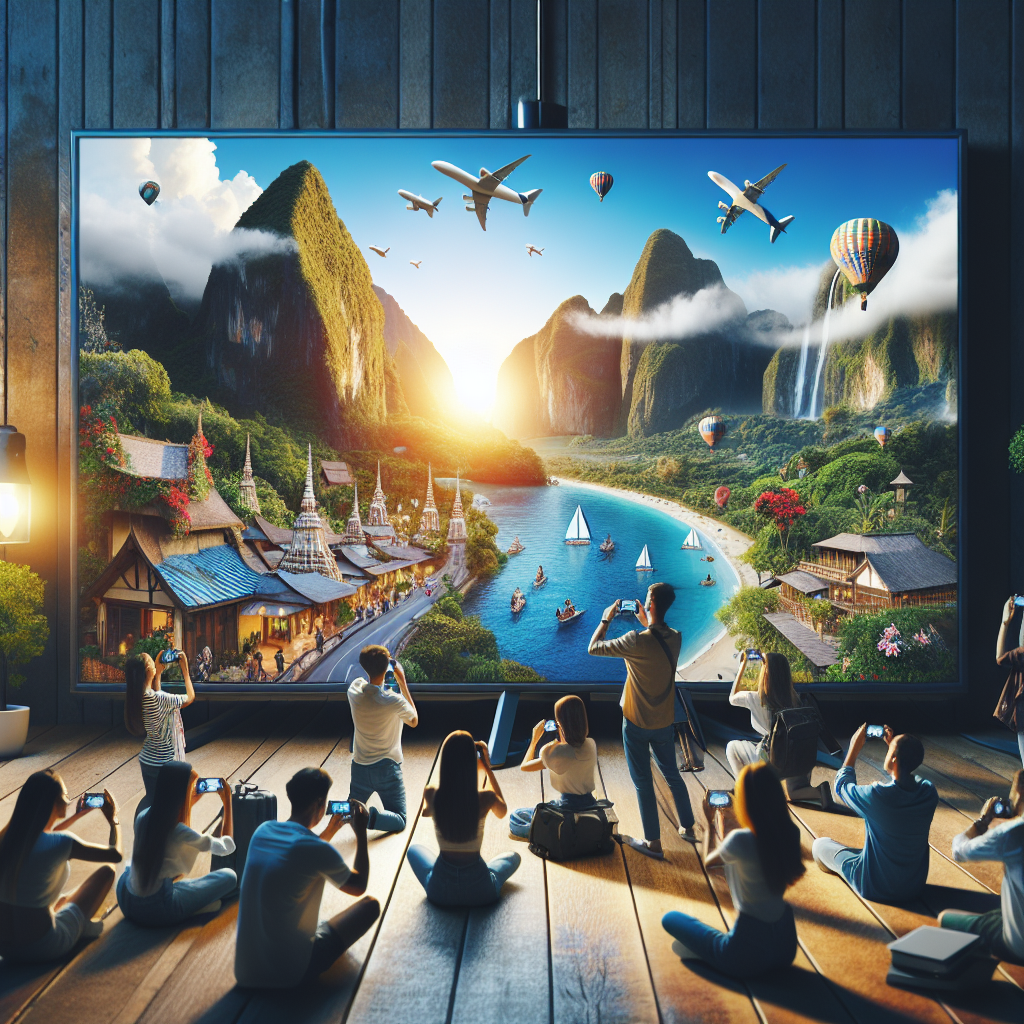How To Find Travel Brands That Work With UGC Creators
Ever wondered how your favorite travel brands use authentic, user-generated content to grow their reach and influence?
You’re not alone! In today’s social media landscape, user-generated content (UGC) is the key to success for many businesses, especially in the travel sector.
The reason behind this is quite simple. People trust the recommendations from their peers and fellow travelers more than polished brand advertisements. As a result, UGC has a significant impact on decision-making, from choosing a holiday destination to booking a hotel.
We already know UGC content is valuable for travel brands – so how do we get these brands to pay us for that value? If you’re looking to level up, this is your guide to getting it right.
Table of Contents
Exploring UGC for Travel
What is UGC?
User-Generated Content (UGC) refers to content created by consumers rather than brands.
This can include photos, videos, reviews, blog posts, and social media updates.
UGC is typically shared online and reflects personal experiences and opinions.
Why UGC is Valuable in Travel
- Authenticity: Travelers trust reviews from fellow travelers over brand messages.
- Engagement: UGC can drive higher engagement rates on social media.
- Social Proof: Positive experiences from other travelers can influence decisions.
Types of UGC in Travel
Many forms of UGC can be beneficial for travel businesses.
Here are a few key types:
- Photos and Videos: Visual content showcasing destinations, accommodations, and experiences.
- Reviews: Written assessments of hotels, restaurants, attractions, and tours.
- Blog Posts: Detailed descriptions and guides written by travelers.
- Social Media Posts: Updates and stories shared on platforms like Instagram and Facebook.
Finding Brands to Work with as a UGC Creator
Networking and Outreach
To get connected with brands, begin by networking both online and offline. Think about the type of brands that align well with your content and reach out to them directly. You can start by sending a pitch email or connecting on social media platforms like LinkedIn.
Join UGC Platforms and Online Communities
There are platforms built to connect UGC creators and brands, such as TRIBE or Takumi. These are useful spaces for creating relationships and finding work opportunities. Participating in relevant online communities can also provide exposure and open doors for collaborations.
Present a Strong Portfolio
Brands will want to see what you can offer, so be sure to maintain a robust portfolio of your UGC work. This includes prior partnerships, audience engagement metrics, and examples of the content you create. An impressive portfolio is an effective selling tool to capture the attention of potential brand partners.
Attend Industry-Specific Events
Industry-specific events, conferences, and trade shows are excellent venues to network and meet potential brand partners. These settings allow for personal interactions which can lead to more genuine relationships.
Activate Social Media Channels
As a UGC creator, managing active social media accounts is a must. Brands often browse social networks like Instagram, Facebook, and Twitter to find influencers to partner with. Regularly posting engaging, high-quality content will improve your visibility to attract brands.
Develop Unique Content
Brands are constantly on the lookout for fresh and unique content. Reflect this in your craft as a UGC creator. Stand out by staying on top of the latest trends, using unique angles, and showcasing your distinctive voice and creativity.
Show Your Engagement Rate
Brands are interested not just in the number of followers you have, but also in your engagement rate. Metrics like comments, likes, shares, and views are critical as they provide insight into how your audience interacts with your content.
Understanding Brand-UGC Creator Collaborations
How Brands Benefit
- Raising Awareness: Collaborating with UGC creators is an effective way to raise brand awareness among potential customers.
- Increased Trust: Given the authentic nature of UGC, it can help build trust between the brand and the consumers.
- Content Variation: UGC creators contribute additional, diverse content helping brands enhance their online presence.
How UGC Creators Benefit
- Promotion: Brands often promote the creator’s content, helping expand their audience reach.
- Rewards: Creators may receive free products, monetary compensation, or other types of rewards for their work.
- Partnership Opportunities: Successful collaborations can lead to ongoing partnerships, allowing creators to have steady work.
For more information on the subject, check out this Social Media Examiner article discussing how to partner with influencers on Instagram.
Finding Brands That Work with Influencers
Research and Identify Relevant Brands
To pinpoint brands that align with your style and niche, start by conducting thorough research. Look for brands that frequently engage with influencers within your content sphere. Utilize search engines, social media platforms, and influencer marketing platforms to gather a list of potential brands.
Utilize Influencer Marketing Platforms
Various platforms specialize in connecting influencers with brands. These platforms streamline the process and offer tools to help you find brands that match your niche. Some popular platforms include:
- Influence.co: This platform offers a marketplace where influencers can discover brands and apply for campaigns.
- Upfluence: Provides an extensive database of brands and helps you manage collaborations.
- AspireIQ: Tailored for both influencers and brands, it simplifies the matchmaking process.
Monitor Social Media Trends
Brands often announce their influencer partnerships and campaigns on social media. Keep an eye on trending hashtags, influencer collaborations, and sponsored posts in your niche. Analyzing these trends will give you an idea of which brands are active in influencer marketing and are a good match for your content.
Engage with Brand Content
Show genuine interest in brands by engaging with their social media content. Like, comment on, and share their posts. Demonstrate your knowledge and passion for their products or services. This not only puts you on their radar but shows that you are an invested and authentic follower.
Leverage LinkedIn for Networking
LinkedIn is a valuable platform for professional networking. Follow and connect with brand representatives, marketing managers, and influencer relations specialists. Participate in industry-relevant discussions and share your insights. Direct outreach through LinkedIn can also be an effective means to pitch collaboration ideas.
Create Brand-Specific Content
Creating content tailored to specific brands can serve as a powerful pitch tool. Showcase how your style aligns with their brand values and target audience. Tag the brand in your posts and use their hashtags. This proactive approach often results in brands taking notice and reaching out for potential collaborations.
Contact Influencer Agencies
Influencer agencies act as intermediaries between brands and influencers. Partnering with an agency can open doors to brands you might not have access to on your own. Some agencies specialize in specific niches, so choose one that aligns with your content and audience.
Review Brand Press Releases
Brand press releases often provide insights into their marketing strategies, including influencer partnerships and upcoming campaigns. Following these releases can help you understand which brands are actively seeking influencers and give you a head start in reaching out.
For more guidance, you can check out this Forbes article on influencer marketing strategies.
Do Influencers Pay for Brand Trips?
The interaction between influencers and brands has evolved into a mutually beneficial relationship. One question that often arises is whether influencers pay for brand trips. Let’s break down how brand trips work and the associated costs.
What Are Brand Trips?
Brand trips, also known as influencer trips, are travel experiences organized and funded by brands. These trips serve as a marketing strategy to promote the brand’s products or services through influencer-generated content.
Financial Aspects of Brand Trips
When it comes to who shoulders the cost of these trips, it generally depends on the type of arrangement between the influencer and the brand.
- All-Expenses-Paid: Many brand trips are all-expenses-paid, meaning the brand covers all costs, including travel, lodging, meals, and activities. Influencers are typically compensated for their time and content creation as part of this package.
- Partial Sponsorship: In some cases, the brand might only cover certain aspects, such as accommodation and activities, while influencers might need to pay for their flights or personal expenses.
- Unpaid Participation: Occasionally, newer or smaller influencers might be invited to join trips without financial compensation. In such scenarios, influencers bear some or all of the expenses, hoping to gain exposure.
- Barter Arrangements: Some collaborations work on a barter basis, where the influencer trades services (like content creation) for the travel experience without monetary exchange.
How Brands Choose Influencers for Trips
Brands are selective when it comes to choosing influencers for trips. Key factors include:
- Audience Alignment: The influencer’s audience should align with the brand’s target demographic.
- Engagement Rate: High engagement rates on social media indicate active followers, which is more valuable than a large but passive following.
- Content Quality: Influencers known for high-quality, visually appealing content are often preferred because their posts are more likely to captivate audiences.
- Brand Affinity: Prior positive mentions or established relationships with the brand can improve an influencer’s chances of being invited.
Expectations from Influencers
Brands have specific expectations which influencers need to fulfill during these trips:
- Content Creation: Influencers are usually required to create and share a predetermined number of posts, stories, videos, or blogs featuring the brand’s products or services.
- Brand Messaging: Ensuring that the content aligns with the brand’s messaging and values is critical.
- Engagement: Interaction with followers about the trip and responding to comments to create buzz around the brand’s offering.
Legal Considerations
There are legal and key factors influencers and brands must keep in mind:
- Disclosure: Influencers must disclose sponsored trips as per FTC guidelines to maintain transparency with their audience.
- Contracts: Clear contracts outlining expectations, deliverables, compensation, and usage rights protect both parties.
- Copyright and Permissions: Ensure all content created can be legally used by both influencer and brand.
Wrapping Up: Maximizing the Power of UGC in Travel and Influencer Relationships
In summary, User-Generated Content (UGC), formed by photos, videos, reviews, and blog posts, serves as an integral tool in the travel industry.
Advantages such as authenticity, social proof, engagement, and numerous others, make UGC an essential strategy for any travel brand. From running contests, creating unique hashtags, to featuring users’ experiences, there are various ways to promote and gather UGC across different platforms.
However, bear in mind the challenges, notably, quality control, negative feedback, and copyright issues. Brands also need to keep an eye on rising creators in the UGC market for potential partnerships, leveraging LinkedIn, platforms like TRIBE, and pitching directly with a strong portfolio.
Influencers can connect with appropriate brands, foster engagement, and even collaborate in brand-specific content. Even when offered ‘brand trips’, the strategy lies in providing stellar content, striking up engagement, and sticking to guidelines.
To sum up, understanding and tapping into this mutually beneficial relationship lead to winning outcomes for brands and influencers alike.
Frequently Asked Questions – FAQs
1. What is User-Generated Content (UGC)?
UGC refers to the content created and shared by consumers rather than brands. In the travel industry, this includes photos, videos, reviews, blog posts, and social media updates about travel experiences.
2. How can brands encourage UGC?
Brands can use several strategies, like running contests, creating unique hashtags, featuring UGC on their platforms, and engaging with users to encourage UGC creation.
3. How can UGC creators find brand partners?
Creators can network both online and offline, join UGC platforms and online communities, maintain a strong portfolio, and engage through social media. High engagement rates and unique content can make a creator more appealing to brands.
4. What are brand trips, and who covers the expenses?
Brand trips are travel experiences organized by brands featuring influencers. Usually, the brands cover all costs, but it ultimately depends on the arrangement between the influencer and the brand. Some trips may be all-expenses-paid, while others might require the influencers to cover certain costs.
5. How do influencers and brands benefit from collaborations?
Brands can raise awareness, build trust, and diversify their content through collaborations. Influencers, on the other hand, receive promotion, rewards, and potential ongoing partnership opportunities which allow for a steady workflow.







